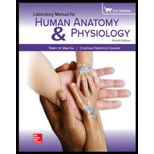
Each hemisphere of the cerebrum regulates
a. motor functions on the opposite side of the body.
b. motor functions on the same side of the body.
c. only functions within the brain.
d. only functions within the spinal cord
Introduction:
The cerebrum is also known as the telencephalon that has two cerebral hemispheres and many subcortical structures. In humans, it forms the uppermost portion of the central nervous system. Cerebrum with the help of the cerebellum controls voluntary actions.
Answer to Problem 1PL
Correct answer:
The correct answer is option (a) motor functions on the opposite side of the body.
Explanation of Solution
Explanation/justification for the correct answer:
Option (a) motor functions on the opposite side of the body. The cerebral hemispheres of the cerebrum are organized contralaterally. The contralateral organization allows the crossing of axonal fibers in the forebrain. This suggests that the axons originating from the left side of the forebrain control the functions on the right side of the body and vice versa. So, the correct answer is option (a).
Explanation for incorrect answer:
Option (b) motor functions on the same side of the body. Motor functions on the same side of the body are controlled by the ipsilateral organization of the axons. Axons arranged in the ipsilateral organization remains on the same side as that of their origin and thus control the motor functions on the same side. Axons originating from the cerebral hemisphere are organized contralaterally. So, this is an incorrect option.
Option (c) only functions within the brain. The axons originating from the cerebral hemisphere reaches the effector muscles that control voluntary actions. So, this is an incorrect answer.
Option (d) only functions in the spinal cord. The cerebral hemisphere is the part of the cerebrum that forms the forebrain (the major portion of the brain). It is responsible for controlling the voluntary actions of the body. So, this is an incorrect answer.
Want to see more full solutions like this?
Chapter 30 Solutions
Laboratory Manual for Human Anatomy & Physiology (Cat Version)
- Identify the indicated cavity (Fucus). a. antheridia b. conceptacel c. receptacle d. oogonium e. none of thesearrow_forwardIdentify the indicated structure (Saprolegnia). a. antheridium O b. oospore c.sperm d. auxospore e. tetraspore Of. zygosporearrow_forwardUsing information from the primary literature (several references have been provided as a starting point below) please answer the following question: Based on your review of the literature on rewilding, what are the major scientific pros and cons for rewilding? Please note that the focus of this assignment are the (biological) scientific issues associated with rewilding. As will be discussed in class, there are a number of non-scientific issues involved or implicated in rewilding, all ultimately affecting the public acceptability of rewilding. Although these issues are important – indeed, critical – in this assignment you should focus on the biological science issues and questions. Details: You must enumerate at least two pros and at least two cons. Your answer should be no more than 500 well-chosen words, excluding references. Think carefully about how best to organize and structure your answer. Aim for high information density: say a lot, but say it succinctly. Recall Nietzche’s…arrow_forward
- Using information from the primary literature (several references have been provided as a starting point below) please answer the following question: Based on your review of the literature on rewilding, what are the major scientific pros and cons for rewilding? Please note that the focus of this assignment are the (biological) scientific issues associated with rewilding. As will be discussed in class, there are a number of non-scientific issues involved or implicated in rewilding, all ultimately affecting the public acceptability of rewilding. Although these issues are important – indeed, critical – in this assignment you should focus on the biological science issues and questions. Details: You must enumerate at least two pros and at least two cons. Your answer should be no more than 500 well-chosen words, excluding references. Think carefully about how best to organize and structure your answer. Aim for high information density: say a lot, but say it succinctly. Recall Nietzche’s…arrow_forwardNow draw a rough sketch of what the control data might look like if in addition to the specific binding, there was also a considerable amount of nonspecific binding (again using a normal dose/response curve) (do % total bound ligand vs concentration)arrow_forwardWhat are functions of cuboidal cells in the kidney? Select all that apply. Concentration of gases Dilution of chemicals Secretion of molecules Nutrition to tissues Support of tissues Absorption of moleculesarrow_forward
- question1 In plants, epithelial tissue is only found as the outermost cell layer and acts as a barrier. In humans, epithelial tissue is found inside the body as well as on the surface. What function(s) does/do epithelial tissue carry out in humans? Select all that apply. Waste storage Filtration Oxygen transport Protection Diffusion Osmosis Absorptionarrow_forwardWhat words best describes this organism? a. Unicellular/nonmotile Ob. unicellular/motile c. colonial/nonmotile d. colonial/motile e. multicelluar O f. siphonous g. none of thesearrow_forwardIdentify the phylum or class. a. Euglenophyta b. Dinoflagellata c. Bacillariophyceae d. Oomycetes e. Phaeophyceae O f. Myxomycota g. Xanthophyceae ○ h. Chrysophyceae i. Dictyosteliomycota O j. Rhodophyta Ok. Chlorophyceaens I. Charophyceaensarrow_forward
 Human Physiology: From Cells to Systems (MindTap ...BiologyISBN:9781285866932Author:Lauralee SherwoodPublisher:Cengage Learning
Human Physiology: From Cells to Systems (MindTap ...BiologyISBN:9781285866932Author:Lauralee SherwoodPublisher:Cengage Learning Biology (MindTap Course List)BiologyISBN:9781337392938Author:Eldra Solomon, Charles Martin, Diana W. Martin, Linda R. BergPublisher:Cengage Learning
Biology (MindTap Course List)BiologyISBN:9781337392938Author:Eldra Solomon, Charles Martin, Diana W. Martin, Linda R. BergPublisher:Cengage Learning Fundamentals of Sectional Anatomy: An Imaging App...BiologyISBN:9781133960867Author:Denise L. LazoPublisher:Cengage Learning
Fundamentals of Sectional Anatomy: An Imaging App...BiologyISBN:9781133960867Author:Denise L. LazoPublisher:Cengage Learning





